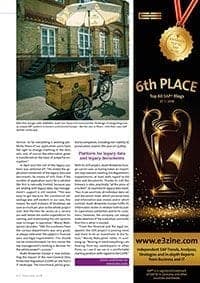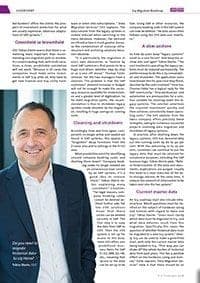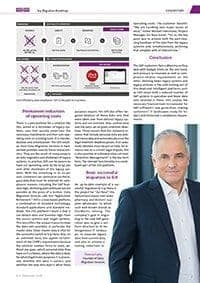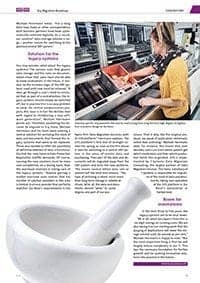This Special Report is available as PDF download at the bottom of the page.
Few topics get as lively a response from SAP customers as the switch to S/4 Hana. There were starting difficulties with the market introduction and there is lasting criticism from the SAP community. Nonetheless, an online survey among 500 decision-makers in the early summer of 2017 by DSAG, the German-speaking SAP usersꞌ group, was revealing. By now almost 64 per cent of firms surveyed are investing in S/4 Hana’s cloud and on-premise versions respectively. By 2020 a third of the SAP customers will switch to SAP’s new generation of software, and now another 20 per cent are already planning the migration for after 2020.
This is a mega-project spanning several years, one that will demand a major share of companiesꞌ IT budget. It will also strongly influence the SAP customersꞌ general IT strategy. This is because it is not about one functionality or another, one sector-specific solution or another. Rather it is about fundamental issues such as the optimum model used for the IT architecture, one that must be sustainable for many years to come.
Also, new compliance rulings, particularly those of the EU’s GDPR, demand a previously unknown degree of transparency and documentation in processing personal data, inside and outside the company’s datacenter. It is no longer enough to have audit-proof storage of this data and the optimum protection against unauthorized access to it. Instead, the firms must now, always and more or less at the press of a button, know and prove where and how personal data is being processed, and by whom. They must always be able to intervene in these processes, for instance to meet their extensive duties to provide information. These duties relate both to the public supervisory authorities and also, and primarily, to people about whom data is stored.
Previously it was a matter of gathering data as comprehensively as possible and storing it safely. Now, despite necessary archiving and back-ups, the data sets to be retained must be minimized and, where applicable, deleted. Only in the rarest cases do legacy systems and legacy archives offer possibilities for this. So, here too, conversions and investments of considerable scale are on the agenda. And time is pressing on. From May 25, 2018 onwards, breaches of the Regulation are subject to penalty.
Squaring the circle
To some degree, the pressure to innovate and new compliance rules challenge IT departments to square the circle somehow. Surveys show time and again that around 60 per cent of the IT budget is consumed by pure IT operations, with only 20 per cent being available for investment in innovations. Often, all of 70 per cent goes towards expenditure for legacy systems. Yet what would be ideal is a split that gives 60 per cent to IT operation and 40 per cent for innovation, on a lasting basis.
Granted, the quoted DSAG survey shows that IT budgets for 2017 grew by almost five per cent on average, compared to 2016. Yet even an increase of that size is not enough to provide the IT departments with the resources needed to digitize their companies and their business models.
Reviewing these figures, the solution is readily at hand. The cost block allocated to operation of the legacy systems must be cut permanently. The chosen resources for dealing with this are consolidation and shutdown. Gartner has also examined this topic, observing providers that enable firms to shut down legacy systems, in its ꞌMagic Square for Structured Data Archiving and Application Retirement,ꞌ most recently updated in June 2016. The key point is that Gartner wants solutions provided to no longer be seen purely as costs. The analystsꞌ firm concludes that ꞌstructured data-archiving and application retirement can bring about a significant ROI.ꞌ
Permanent reduction of operating costs
There is a precondition for a solution like this, aimed at a shutdown of legacy systems, one that quickly amortizes the necessary investments and then cuts operating costs on a lasting basis. It is standardization and amortization. The JiVS solution from Data Migration Services in Switzerland provides exactly these characteristics.
They are the result of many projects on data migration and shutdown of legacy systems. In practice, JiVS can be proven to have cut operating costs by 80 to 90 per cent after shutdown of the legacy systems. With the remaining 10 to 20 per cent, customers can continue to use the legacy data that must be retained for compliance reasons, including the SAP business logic. Archiving and continued use are possible at the press of a button. Data Migration Services calls this ꞌApplication Retirement.ꞌ
JiVS is a Java-based platform, a combination of standard technology, standard applications and standard methods. The JiVS platform’s heart is that it can detach data and business logic from the source systems and target systems. This also offers the unique chance to clean the data sets available, in particular the master data. Clean master data is vital for the successful switch to S/4 Hana.
Also, on an unlimited basis, this applies to fulfilment of the EU-GDPR’s requirements because the solution enables firms to state, without any gaps, which personal data they have on EU citizens, where the data is kept, for what (legitimate) purposes it is processed, whether this data is correct, and whether the only data kept is what these purposes require. Yet JiVS also offers targeted deletion of those data sets that were taken over from defunct legacy systems and are archived. Also, archive data and live data can be given retention deadlines. These ensure that (for instance) invoices that include personal data are deleted irrevocably and automatically once the legal retention deadline passes. If an automatic deletion must be put on hold, for instance due to a current legal dispute, this is also possible at individual-data-set level. ꞌRetention Managementꞌ is the key term here. The relevant functionality is a constituent part of the JiVS platform.
Rose: successful migration to S/4
An up-to-date example of a successful migration to S/4 Hana is the project for ꞌZur Roseꞌ, the Switzerland-based mail-order pharmacy and doctors‘ supplies wholesaler, to which such well-known brands as DocMorris belong. The companyꞌs goal in migrating to the new SAP generation was to give a uniform structure to its heterogeneous IT landscape, to separatelegacy data from current data, and also to achieve a lasting reduction in operating costs.
The customer benefit: ꞌWe are handling two major issues at once,ꞌ noted Michael Herrmann, Project Manager, Zur Rose Suisse. ꞌFor us, the key point was to achieve both the post-cleaning handover of the data from the legacy systems and, simultaneously, archiving that complies with all relevant law. ꞌ
Conclusion
The SAP customers face a dilemma as they deal with budget limits on the one hand, and pressure to innovate as well as compliance-related requirements on the other. Shutting down legacy systems and legacy archives is the path leading out of this dead-end. Intelligent platforms such as JiVS mean both a reduced number of SAP systems in operation and fewer data sets retained in them. JiVS creates the necessary financial room to maneuver for SAP software’s new generation, making customersꞌ IT landscapes ready for today’s and tomorrow’s compliance requirements.
Continue reading by clicking on the arrow on the right side of the screen.
































Add Comment